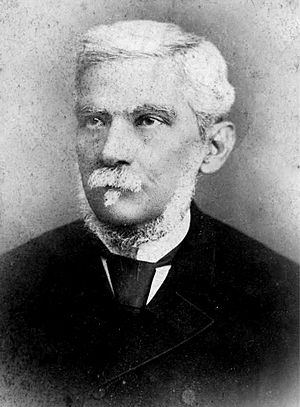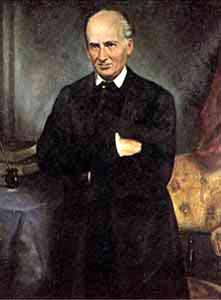Bartolomé Calvo facts for kids
Quick facts for kids
Bartolomé Calvo
|
|
|---|---|
 |
|
| 2nd President of the Granadine Confederation | |
| In office 1 April 1861 – 18 July 1861 |
|
| Preceded by | Mariano Ospina Rodríguez |
| Succeeded by | Ignacio Gutierrez Vergara |
| 3rd Governor of Panama | |
| In office 1 October 1856 – 1 June 1858 |
|
| Lieutenant | Francisco Fábregas |
| Preceded by | Francisco de Fábregas |
| Succeeded by | Ramón Gamboa |
| 8th Envoy Extraordinary and Minister Plenipotentiary of Colombia to Ecuador | |
| In office 18 April 1886 – 20 January 1889 |
|
| President | Rafael Núñez |
| Preceded by | Sergio Camargo |
| Succeeded by | Francisco de Paula Urrutia Ordóñez |
| Personal details | |
| Born |
Bartolomé Calvo Díaz de Lamadrid
24 August 1815 Cartagena de Indias, Bolívar, United Provinces of New Granada |
| Died | 2 January 1889 (aged 73) Quito, Pichincha, Ecuador |
| Resting place | Central Cemetery of Bogotá |
| Nationality | Colombian |
| Political party | Conservative |
| Spouse | Isidora Martí |
| Alma mater | University of Magdalena |
| Occupation | Lawyer, Diplomat, Journalist (Typographer, Editor) |
Bartolomé Calvo Díaz de Lamadrid (born August 24, 1815 – died January 2, 1889) was an important Colombian lawyer, journalist, and politician. He became the President of the Granadine Confederation, which is now part of Colombia, in 1861. He took on this role as the Inspector General of Colombia because no elections were held that year. He also served as the Governor of Panama and as an Ambassador to Ecuador. Besides his political career, he worked for several newspapers.
Contents
Early Life and Education
Bartolomé Calvo Díaz de Lamadrid was born on August 24, 1815, in Cartagena de Indias. At that time, this city was part of the United Provinces of the New Granada. He became an orphan when he was very young. He spent his youth working in the print shop that his father left to him and his brothers. Later, he went to the University of Magdalena and studied Jurisprudence, which is the study of law.
He was married to Isidora Martí.
Working as a Journalist
Bartolomé Calvo loved journalism, just like his father, who was one of the oldest printers in Cartagena. After finishing his studies, he worked for newspapers like La Civilización and La República. Later, he moved to Panama and became the publisher and editor of El Correo del Istmo.
He then became the main editor for La Estrella de Panamá. This was the Spanish part of a newspaper printed in three languages called The Daily Star & Herald. Calvo had very strong political opinions. These opinions did not always match what the newspaper owners wanted for their business. Calvo refused to change his views, which eventually led to the closing of La Estrella and him losing his job.
Politics in Panama
When Francisco Fábregas became the acting governor of Panama, he chose Bartolomé Calvo as his Secretary of State. During this time, there were many problems and tensions between different groups of people, especially involving Americans living in Panama.
On April 15, 1856, an event called the Watermelon Riot happened. This incident caused a lot of trouble for the government. The United States blamed the Panamanian administration, and they had to pay a lot of money for damages.
Later, elections for Governor of Panama were held on August 15, 1856. Bartolomé Calvo was one of the candidates. The elections were very complicated, and it was hard to decide who won. Finally, on September 18, the Legislative Assembly of Panama declared that Bartolomé Calvo had been properly elected for two years.
Bartolomé Calvo officially became the Governor of Panama on October 1, 1856. He was known for his good leadership and honesty. His time as governor was successful. He encouraged public education and helped improve the state's money situation.
In 1858, Calvo was chosen to be the Inspector General of Colombia. He left Panama on May 5 to go to Bogotá, handing over his power to Ramon Gamboa.
Becoming President in 1861
In 1861, Colombia was going through a Civil War. The country was then called the Granadine Confederation. The president at the time, Mariano Ospina Rodríguez, was struggling to control the government. That year, the Congress was closed, and no presidential elections were held.
President Ospina's term was ending. According to the country's rules, if there were no elected successors, the Inspector General would become president. So, on April 1, 1861, Bartolomé Calvo Díaz de Lamadrid became the President of the Granadine Confederation. He served as the Inspector General in charge of the country's executive power.
Coup and Time in Exile
On July 18, 1861, General Tomás Cipriano de Mosquera's forces attacked and took control of Bogotá. They arrested many important people, including Bartolomé Calvo and the former president, Mariano Ospina Rodríguez. They were taken to Bocachica Castle in Cartagena as prisoners.
From there, Calvo managed to escape to the Antilles. He then traveled to Puerto Rico, where he lived in exile for a while. In 1867, he moved to Guayaquil, Ecuador, where his brother Juan Antonio lived. Together, they started the city's first newspaper, Los Andes. This newspaper was politically neutral and became very important at the time.
Presidential Election of 1876
In 1876, Bartolomé Calvo was nominated to run for President of Colombia. He returned to his country for the elections. He ran as a candidate for the Conservative Party. His opponents were Aquileo Parra from the Radical Liberal Movement and Rafael Núñez from the National Liberal Party.
During the voting in the Senate, no candidate received more than half of the votes (an absolute majority). Because of this, the election went to a second round of voting. This second vote took place in the Chamber of Representatives, where Aquileo Parra was declared the winner.
| Candidate - Party | Votes in Senate | Votes in Congress |
|---|---|---|
| Aquileo Parra - Radical Liberal | 5 | 48 |
| Bartolomé Calvo - Conservative | 2 | 18 |
| Rafael Núñez - Liberal | 2 | 18 |
| None of the above – (Voto en Blanco) | 1 | 0 |
Time in Ecuador
In 1884, Calvo was chosen to be the Plenipotentiary Minister (a high-ranking diplomat) to Ecuador. However, he could not start his job right away because of the Colombian Civil War of 1885, which stopped many political activities. He officially arrived in Quito and began his post on April 18, 1886.
In 1888, he was elected as a senator in the Colombian Congress. But he chose to stay in Ecuador and refused the offer.
Death and What He Left Behind
Bartolomé Calvo Díaz de Lamadrid passed away in Quito, Ecuador, on January 2, 1889. He was 73 years old. He left behind his wife but had no children.
On October 10 of the same year, the Congress of Colombia passed a special law. This law expressed sadness over the former president's death. It also set aside money to bring his remains back to Colombia. His body was to be buried in a National Monument at the Central Cemetery of Bogota. The law also asked for two oil paintings of him to be made. One would hang in Congress, and the other would be given to his widow. Additionally, two busts (sculptures of his head and shoulders) were to be created. One would go to the city of Cartagena, and the other to the Panamanian Assembly. These were all done to honor and recognize his service to the nation.
The Bartolomé Calvo Library in Cartagena de Indias was also named in his honor.
See also
 In Spanish: Bartolomé Calvo para niños
In Spanish: Bartolomé Calvo para niños
- Colombian Civil War (1860–1862)
- Granadine Confederation
- Clímaco Calderón


